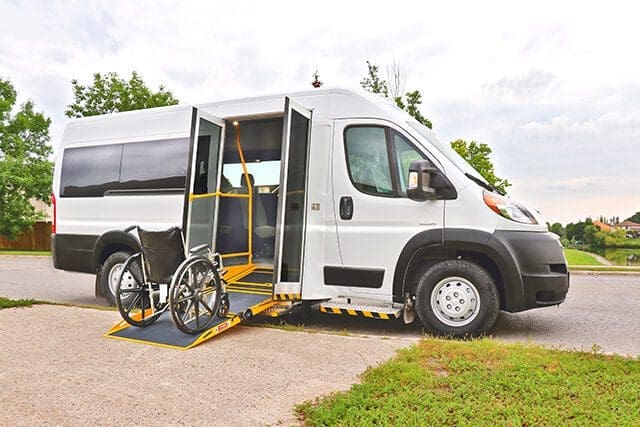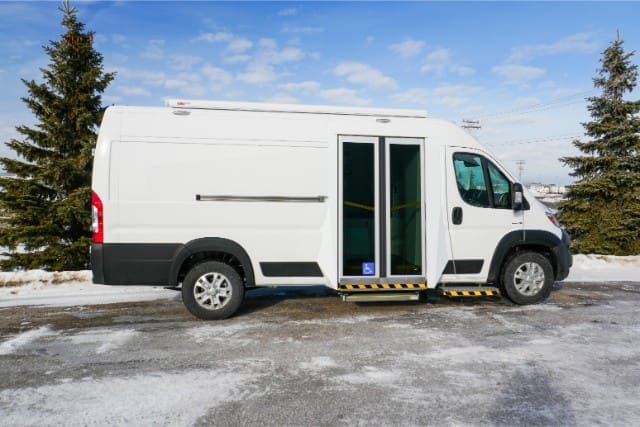Are you part of an organization in the U.S. thinking about getting a wheelchair van but feeling unsure where to start? You might be worried about making sure the van meets all accessibility needs and fits within your budget. The process can feel overwhelming, and you might be concerned about making the right choices for the people who depend on you.
Should you modify your current van, or is it better to purchase a new one and convert it? Making the wrong choice can leave you with a money pit you can’t afford and clients you can’t serve. We understand how important this decision is for you and the people you serve, and we’re here to help guide you through it.
At AVAN Mobility, we have over ten years of experience making vans accessible. We know exactly what changes a vehicle needs to reach the level of accessibility your clients need, and we also know which van models work best. Keep reading to learn from the experts!
In this article, you will learn about the six steps to make a van wheelchair accessible. We’ll walk you through each step, and by the time you’re done reading, we hope you’ll have more clarity and direction on how to move forward.
What exactly makes a wheelchair van accessible?
A wheelchair accessible van is designed to make it easy for someone in a wheelchair to get in and out safely and comfortably.
How is this done?
Wheelchair ramp or lift: These are the most important parts. A ramp allows someone to roll their wheelchair into the van, while a lift can raise and lower the wheelchair into the van. Many accessible vans in the U.S. come with one of these options.
Side or rear entry: You’ll typically see the ramp or lift placed on the side or back of the van. This choice depends on how you plan to use the van and what is more convenient for the users.
Modifications: Many changes are required to make the van wheelchair accessible, often running up to 40 different alterations.
Converting a van to be wheelchair accessible in the U.S. can involve many steps, but it’s all about making sure the van is safe and comfortable for everyone who uses it. Now, let’s go through the basic steps to make a van wheelchair accessible.
3 basic steps to make a van wheelchair accessible

Making a van wheelchair accessible involves a few key steps to ensure that it is safe and comfortable for users. Here are the three basic steps technicians follow to convert a standard van into a wheelchair accessible van.
1. Lower the floor (certain models)
Increase Headroom: Lowering the floor gives wheelchair users more headroom in some vans. This makes it comfortable for them to sit inside without hitting their heads on the roof.
Decrease ramp angle: In some situations, lowering the floor also helps reduce the angle of the ramp, making it easier for wheelchair users to get in and out of the van. A less steep ramp is easier to navigate.
2. Install a ramp or a lift

Ramp installation: A ramp provides a slope for the wheelchair to roll into the van. It’s installed to be deployed when needed and stored when not in use. Sometimes, the floor needs to be lowered to make the ramp less steep.
Lift installation: A wheelchair lift is mounted to the van and can raise and lower a wheelchair vertically. The floor doesn’t have to be lowered with a lift because lifts can easily raise the wheelchair to the van floor’s level.
*Keep in mind that AVAN Mobility only offers ramp options for wheelchair vans at this time.
3. Install safety securements
Securement systems: Safety is the most important part of making a van wheelchair accessible. This involves installing a self-tightening wheelchair securement system that holds the wheelchair in place during travel.
In the next section, you’ll learn about what alterations our team at AVAN Mobility can make to your van. Continue reading to learn more about that.
What alterations can we make to your wheelchair accessible van?
At AVAN Mobility, we can make a variety of changes to your van so it meets all the needs of wheelchair users. Here are some of the key alterations we can make:
Strip the Van’s Interior
First, we start by removing the interior finishing of the van. This includes taking out:
- Seats
- Carpet
- Flooring
- Sidewalls
This step helps us prepare the van for the necessary modifications in the next steps.
Van modifications
Next, we make the following modifications to your van to make it wheelchair accessible:
Install ramp system: We can install a ramp system that allows easy entry and exit for full size vans.
Upgrade door systems: We can install any type of door system that best suits your needs, whether it’s for the side or rear entry.
Add insulation: Insulation can be added to keep the van comfortable in all weather conditions.
Install AutoFloor: In full size vans, we can install AutoFloor systems, which provide flexible seating arrangements.
Electrical wiring: We handle all the necessary electrical wiring to ensure all components work seamlessly.
Interior finishing
Finally, we put the van back together. This includes installing:
- Interior paneling
- Lights
- Ceiling
- Seats
- Wheelchair restraints
- Stickers
- Emergency equipment
We make sure everything is set up perfectly so that the van is ready to use safely and comfortably.
With all these alterations, your van will be fully equipped to provide the best experience for wheelchair users. Curious about how AVAN Mobility transforms a standard van into a wheelchair accessible one? Let’s dive into the 6-step process.
How do you get started with your wheelchair van conversion at AVAN Mobility?

If you decide to choose us for your next wheelchair van conversion, you can expect a 6-step van conversion process.
Step 1: Reach out to us
The first step is to contact us. Give us a call or send us an email, and we’ll start the conversation about converting your van to be wheelchair accessible.
Step 2: Custom needs analysis
Next, our sales team will conduct a custom “needs analysis.” We’ll ask questions like:
- How many passengers will you be transporting daily?
- Do your passengers use manual or powered wheelchairs?
These questions help us understand exactly what you need.
Step 3: Choose a model
Based on the needs analysis in step 2, we’ll help you choose the right van model. We provide all the necessary information and guidance so you can make the best decision.
Step 4: Deposit and paperwork
Once you’ve decided on a model, you provide a deposit and sign the necessary paperwork. After that, we put your van into production.
Step 5: Building your van
We then get to work on building your van. Our expert technicians handle all the modifications and installations to ensure your van is fully accessible and meets all safety standards.
Step 6: Final payment and delivery
Once your van is ready, you make the final payment. We then deliver the van to you, fully equipped and ready to provide safe and comfortable transportation for wheelchair users.
Ready for your next wheelchair accessible van?
You came to this article looking for guidance on making a van wheelchair accessible for your organization. We understand the challenges you face and the importance of making sure your van meets all accessibility needs.
In this article, you first learned about the three basic steps to make a van wheelchair accessible, including lowering the floor, installing a ramp, and adding safety securements. We also discussed the alterations our team at AVAN Mobility can make to your van and our straightforward six-step process to meet your needs.
At AVAN Mobility, we work with U.S. organizations like yours, who use our vehicles to assist people in need of accessible transportation. Our commitment to quality, safety, and customer satisfaction sets us apart as leaders in the industry. If you have any questions, please click the button below to talk to a mobility expert. We’re dedicated to finding the best solutions for your organization’s needs.
If you’re not ready to talk to a mobility expert yet, we have a few other resources you should check out to learn more.
Start by checking out our video below on the cost of a wheelchair van.
You should also check out one of our wheelchair vans, which can provide stretcher, wheelchair, and ambulatory transportation in one vehicle.





